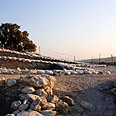
In the footsteps of kings: Following King David in the Judean lowlands
Almost everywhere in Israel is mentioned in the Bible. A new series of articles in cooperation with Yad Ben Tzvi institute attempts to find the connection between the ancient stories and today's scenery. Part one: Following King David in the Judean lowlands
The tour starts at Haruvit Forest in Adulam region. Hiking trails lead from the forest; one, green, leads up the road to the barrow from the east; the other, black, climbs up the barrow from the west.
Tel Tzafit, where the ancient Philistine city of Gath stood (Photo: Gili Sofer)
The barrow – Tel Tzafit – was positively identified after a long debate as the location of the ancient Philistine city of Gath. King David arrived at the home of Achish, the Philistine king, when he fled the wrath of King Saul as tension grew between Saul and David following David's victory over Goliath. Shamelessly, David asked Achish for asylum, while he was holding his enemy Goliath's sword. In present days, we might call it "Israeli chutzpa."
Later on David finds refuge with Achish as he again flees Saul, this time accompanied by his loyal army of 600 men and his two wives. " And David said in his heart, I shall now perish one day by the hand of Saul: there is nothing better for me than that I should speedily escape into the land of the Philistines; and Saul shall despair of me, to seek me any more in any coast of Israel: so shall I escape out of his hand." (First Book of Samuel 27:1)
In other words, David felt at home in this place. When he became king, he gave Gath the status of an independent Philistine city (probably to show his gratitude for the help he received from King Achish). Moreover, the commander of King David's machinery army was Ithay from Gath.
The many relics found in Tzafit Barrow point at the presence of a continuous settlement in the area from the beginning of the second millennium BC until the final days of the Roman Empire. There are no findings from the Middle Ages, but then the Crusaders built there a fortress called the White Fortress.
An Arab village was built on the ruins of the fortress, and was deserted during the Independence War in 1948.
Path laid with stones telling the story of the battle
After we finish touring the barrow, we return to the forest and turn east toward Tel Azekah.
As we climb up the barrow we will read on the stones laid throughout the path the tale of the battle between David and Goliath which took place at the foothill. Like two gunmen in a western, the giant Philistine faced his Jewish counterpart. David was quicker to draw his slingshot. Goliath collapsed under his weight, "And he had an helmet of brass upon his head, and he was armed with a coat of mail; and the weight of the coat was five thousand shekels of brass… And the staff of his spear was like a weaver's beam; and his spear's head weighed six hundred shekels of iron: and one bearing a shield went before him." (First Book of Samuel 17:5-7)
Tel Azekah, 347 meters above sea level, overlooks eastwards and on a clear day, it is possible to see the Mediterranean.
Leaving Tel Azekah we head south on route 375 towards Tel Shochoh which is mentioned in the Bible as the battleground between Israel and the Philistines: "Now the Philistines gathered together their armies to battle, and were gathered together at Shochoh, which belongeth to Judah, and pitched between Shochoh and Azekah, in Ephesdammim" (First Book of Samuel 17:2-4)
The battle of David and Goliath (Photo: Visual/Photos)
Look around you and imagine the army of Israelites led by David and Saul on one side, and the Philistine army on the other. The signal is given and the bloody battle begins: sharp swords, heavy shields, soldiers yelling, wallowing in blood. By the end of the day, the Philistines are defeated and the Israeli women sing: "And the women answered one another as they played, and said, Saul hath slain his thousands, and David his ten thousands." (First Book of Samuel 18:7)
Getting there
To Haruvit Forest drive on road 383 and turn east on Re'em junction or west on Azekah junction.
Gadi Vexler is a senior tourguide at Yad Ben-Tzvi













